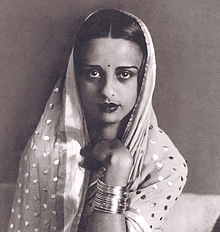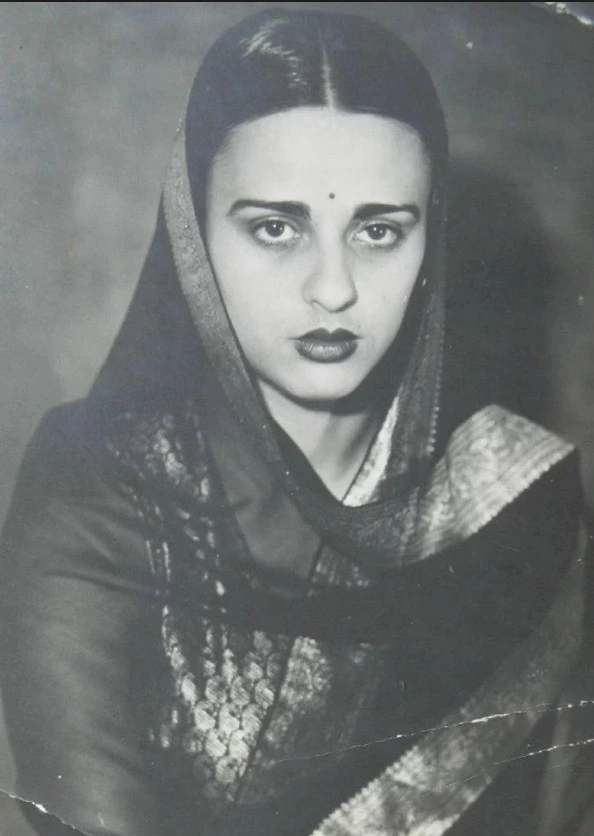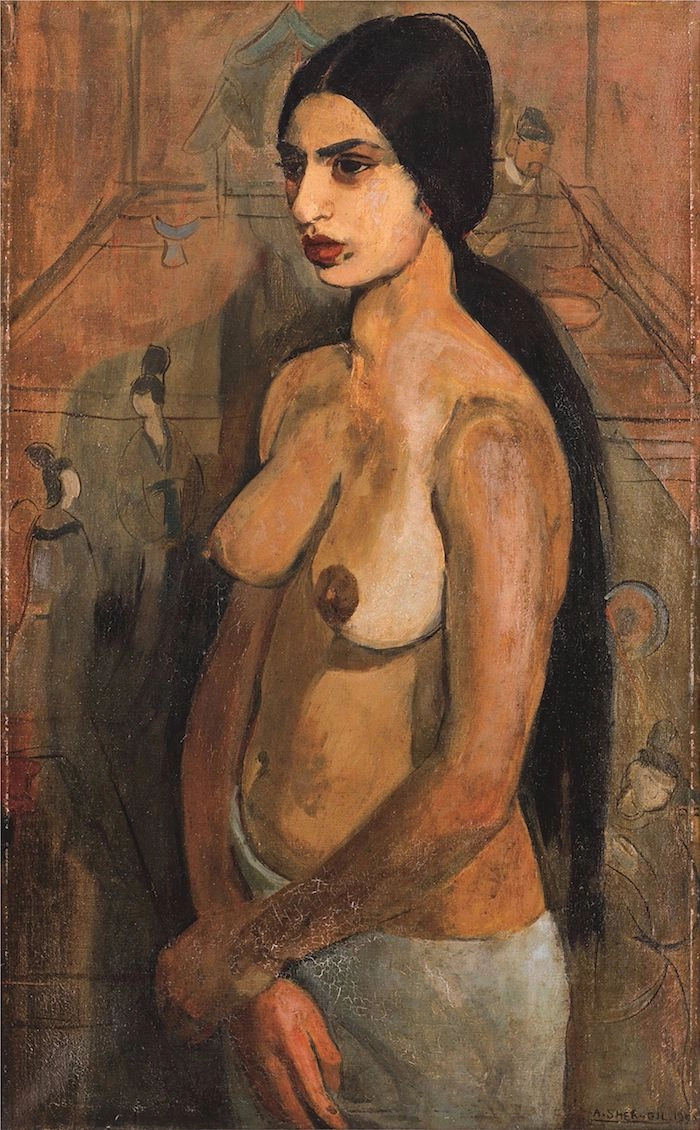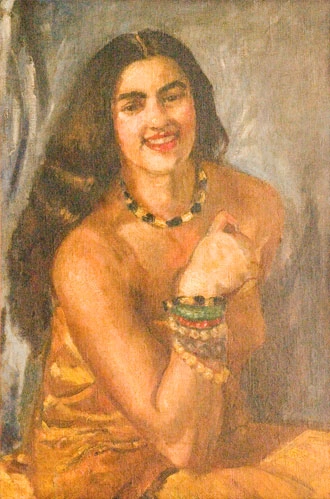Amrita Sher Gil – The James Dean Effect
by David Fox
Amrita Sher Gil is one of the most impressive and the most gifted Indian artists of the pre-colonial era.

India’s Revolutionary Artist
She is considered as a revolutionary woman artist and pioneer of modern art in India, and often referred to along with Frida Kahlo for aesthetically blending traditional and Western art forms.
She was born on January, 30, 1913 in Budapest, Hungary. Her mother Marie Antoniette Gottesmann was a Hungarian-Jewish opera singer, and her father Umrao Singh Sher-Gil Majithia was a Sikh aristocrat and a Persian and Sanskrit scholar.
She developed an interest towards painting at her early childhood, by the time she was five. In 1921, Amrita’s family shifted from Hungary to the beautiful hill station of Shimla, due to financial problems.

The young Amrita started to learn painting at the age of eight, trained under Major Whitmarsh and Beven Paterman.
A few years later, she joined a famous art school in Florence, Santa Annunziata, where she was exposed to the works of Italian artists, which furthered her interest in painting.

Months later, Amrita and her mother returned to India.
Realizing Potential in Paris
In 1926, Amrita’s nephew Ervin Baktay, an Indologist aware of her amazing potential, played a crucial role in pushing her to pursue an artistic career.
At the age of 16, she went to Paris with her mother and started training under Pierre Vaillend and Lucien Simon at Grande Chaumiere, and received a formal education at the École des Beaux-Arts.

She spent five years in Paris. It was a period of experimentation, and a period of exploring her own hybrid identity. Sher-Gil was fully aware of her exotic beauty, sometimes wearing western clothing, and sometimes wearing a sari.
During the initial stages of her career, her works were profoundly influenced by Western art, reflected academic style in which she was trained. It was the Western European idiom with its naturalism and textured application of paint.
In the early 1930s, many of her pieces included paintings of her Parisian life, still life studies, nude studies, portraits of her friends and fellow students, and the significant corpus of the self portraits, for which she is often considered as narcissistic by many.
The self portraits captured the artists in her many moods-pensive, joyous and obscure, while revealing a narcissistic line in her personality.

Pitiless Eye, Melancholic Soul
In 1932, she created The Young Girls: the two women- Amrita’s sister Indira sits on the left clothed in chic European style and a French friend Denise Proutaux partially undressed figure in the foreground.
The two women, one assured the other awkward with her face buried beneath streaming hair have been as personifying two different side of the artist herself.

Sher-Gil was the youngest and the only Asian artist to be elected as an Associate of the Grand Salon in Paris. The painting was gained wide recognition and was awarded a Gold Medal at the Parisian Grand Salon in 1933.
One of Sher-Gil’s professor predicted that her works would make more sense in the East, judging by the rich colors that she usually used in her painting.
Sher-Gil created self-portraits that represented her grappling with her own identity. These paintings often reflected troubled and introvert woman caught between her Indian and Hungarian existence.

Gaugin’s Disciple
She was profoundly influenced by the simplified and symbolically charged paintings of Paul Gauguin. It became explicit in Self Portrait as Tahitian (1934), where Sher-Gil appear in a three-quarter profile naked to the waist, and looking beyond the frame of the picture.
Her body is depicted in Gauguin’s technique of the female nude with a distant, obscure expression of her face. She self-consciously plays on her status as the exotic other in Paris.

In 1934, Sher-Gil returned to India in order to find a mode of delineation appropriate to her Indian subjects.
Decoding Indian Traditions
A few years later, 1937, in order to decode the traditions of Indian art she began her journey to the south India, a journey that shaped all her future work.
Sher-Gil was deeply moved by the plight of unprivileged people and common villagers; she explored the sadness felt by people, especially women, giving voice and validity to their experience.
It would reflect in her work South Indian Trilogy (Bride’s Toilet, Brahmacharis and South Indian Villagers Going to Market) are much different from the prevalent realist watercolor mode of Indian painting at that time.

Her artistic style and technique was indeed fairly unusual in India. Influenced by the wall painting of the Ajanta Caves, she attempted to fuse their aesthetics with the European oil painting techniques.
She had learnt to incorporate Indian traditions in her work and rediscovered her purpose in painting. Once she even wrote to a friend saying that Europe belongs to the artists such as Cézanne, Picasso and Matisse while India belongs to her.
Her artistic style was in marked contrast to that of her contemporaries in India – Nandalal Bose, Abdur Rahman Chughtai and Abanindranath Tagore, who belonged to the Bengal school, as the first modern movement of Indian art.
She considered the school retrograde and blamed it for the stagnation in Indian painting of that time.

In the following years, her work had a tremendous impact on Indian art. As an exceptional colorist, Sher-Gil was able to achieve special effects with colors that were bold and unbridled, in opposite to the pale hues in vogue among her contemporary colleagues.
Some of the best examples of her work such as Village Scene, Siesta or In the Ladies’ Enclosure represented the poor state of women and other unprivileged people.

Understanding
The painting Three Girls, from 1935, shows melancholic women wearing passive expressions; their solemn brown faces a contrast to the vibrant reds, ambers and greens of their clothing.
The mood is dispirited – the women are waiting for something they doubt will ever come along. Sher-Gil lived between worlds, between West and East, in searching for a sense of belonging.
So, she understood the emptiness and loneliness of those women, since their moods were a certain reflection of her own.
In 1941, Sher Gil moved to Lahore, an undivided part of India, where the art was appreciated at that time. In this phase of her life, she produced some of her most known painting such as Tahitian, Bride, Hill Scene and The Red Brick House.

Living Free, Dying Young
Amrita Sher-Gil was a free spirit who led a somewhat careless life; she was bisexual and had numerous relationships.
Regarding her sexuality, her biographer Yashodhara Dalmia in Amrita-Sher-Gil: A Life (2006) wrote it was (partly) a result of her broad view of woman as a strong individual, liberated from the social conventions.
She formed an intimate friendship with the painter Marie Louise Chassany who was a fellow student at the Ecole des Beaux Arts in Paris. Some art critics believed her painting Two Women reflected their yearning for one another.

Sher-Gil saw marriage as a way to gain independence from her parents. In 1938, she married Dr. Victor Egan, her Hungarian first cousin, revealing afterward that she was pregnant; Dr Egan arranged for an abortion and performed it.

She was a close friend of Jawaharlal Nehru, the first Prime Minister of India and central figure in Indian politics before and after independence. She never painted Nehru, as she stated he was ‘’too good looking to be painted’’.

In 1941, days before her first solo exhibition in Lahore, she became ill. A few months later, she died at the age of 28.
The real cause of her death was never ascertained. The cause was believed to be complications from a second abortion performed by her husband. Her mother accused Dr Victor Egan, for her demise.
Her unfinished works reveal a move toward abstraction and incorporate richer colors that the colors seen in her previous paintings.

The artwork of Amrita Sher-Gil has been declared as National Art Treasures by the Government of India.
In 1978, India Post released a stamp of her ‘Hill Women’’. The Indian cultural center in Budapest has been named after her. The 100th anniversary of Amrita Sher-Gil’s birth was declared as the international year of Sher-Gil by UNESCO, in 2013.
The complexities of her life made her both, an outsider and insider, as did her ambivalent sexuality and identity-pushed her to constantly reinvent her artistic style and visual language.
She sought to adjust and reconcile her enthusiastic response to traditional art-historical resources with her modern sensibility.
Recommended Viewing on Amrita Sher-Gil:

About David Fox
David Fox is an artist who created davidcharlesfox.com to talk about art and creativity. He loves to write, paint, and take pictures. David is also a big fan of spending time with his family and friends.
Leave a Reply
 |
 |
 |
 |
Just Art and Fun
Now get FREE Gifts. Or latest Free phones here.
Disable Ad block to reveal all the secrets. Once done, hit a button below
 |
 |
 |
 |